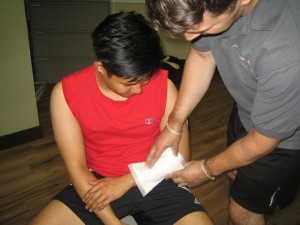The pressure points can be utilized during emergencies in order to diminish the circulation to certain areas in the body. Through the reduction of bleeding, it will allow the individual to survive the waiting period until medical care can be provided as well as prevent the individual from going into shock. In traumatic accidents, internal bleeding might occur which could not be easily controlled with the application of direct pressure.
If the individual has bruises, vomits blood or have other indications of possible bone damage or bleeding from the genitalia, it is best not to intervene. In case the individual is cold, has moist skin or seems to have difficulty breathing, it can be life-threatening which would require medical care. If the medical team is on the way, you can help the individual to sit down or lie down. If possible, the affected limb should be elevated above the heart in order to minimize the flow of blood to the wound. You have to locate for a pulsating feeling at the suitable pressure point. You can learn about these pressure points by enrolling in a first aid course today.

Face or head wounds
You have to trace starting from the outer corner of the eye towards the ear. You will feel a dip close to where the ear starts to extend from the head. You have to press and hold to check for a pulse which will indicate the temporal artery.
Neck wounds
Start tracing from the center of the Adam’s apple and stop right before the ropey-like neck muscles. You will feel a strong pulse which indicates the carotid artery which is responsible for supplying blood to the brain. Do not apply pressure for a long time since this can lead to loss of consciousness.
Groin wounds
You have to look for the femoral artery within the center of the lowest crease in the groin which is amidst the groin and upper thigh. Take note that this artery would require substantial pressure by pressing down using the entire heel of the hand to reduce the circulation.
Upper arm and elbow wounds
Locate the brachial artery on the interior side of the arm right above the elbow bone in between the large upper arm muscles. Take note that this artery might not be as evident as the carotid artery.
Lower leg wounds
You have to press the rear part of the knee directly at the rear of the kneecap in order to gain access to the popliteal artery. The individual should not move or bend the leg. You have to reach around the rear part of the leg and press up.
Hand and feet wounds
On the interior of the wrist, move starting from the thumb up to the tip of the forearm. As for wounds on the feet, you have to trace over the upper part of the foot where it connects with the shin. In both circumstances, you have to sense for a pulse before pressure is applied.
